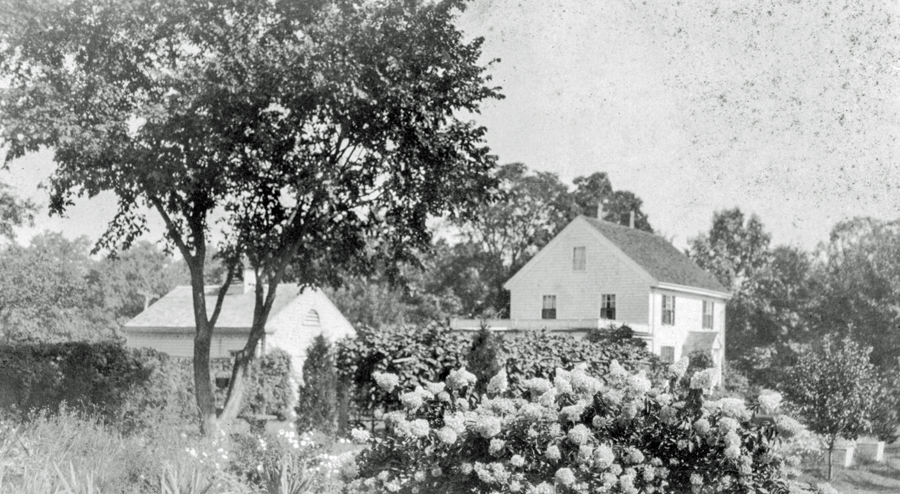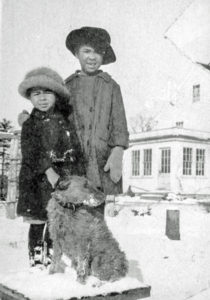Canton’s True Tales: Give Them Their Due
By George T. ComeauThe modest white house at 154 Dedham Street is most unassuming, yet it is one of our most important unmarked national historic sites owing to the family that moved there in the early 1900s. And while much has been written about Augustus Hinton, little has been written about his daughters and wife. Augustus (Gus) Hinton was the first African American to hold the rank of professor at Harvard University in its 313-year history. He is most widely known as the creator of the Hinton Test, the most effective test leading to the diagnosis of syphilis. Wife Ada was director and vice president of the Home for Aged and Colored Women in Boston and headed up the Canton Community Club and the local nursing association. And Jane Hinton, one of his daughters, is equally important to the development of microbiology and at the same time veterinary medicine. This was a power family.
Gus’s story has been shared before in this very column, but his wife and his two children have always been behind the scenes in much of the telling of the history. Ada was born in Macon, Georgia in 1888. She had a fabulous education at a time when women of color were rarely afforded such opportunities. Attending Atlanta University, she graduated in 1901and then in 1906 received a master’s degree in mathematics from Chicago University. After her studies, Ada went on to become a teacher and a social worker.
Ada and Gus met in Oklahoma while she was teaching Latin. They married in 1909 and that same year moved to Boston and rented a small apartment at 52 Fenwood Road, Jamaica Plain. Later they lived at 1516 Cambridge Street in Cambridge near Harvard, and Gus took at least one trip to London in the spring of 1914. By 1916 they moved to Canton with their newborn daughter Ann. “We bought a nice big dining room table, and needed a house appropriate for a dining room,” Gus said. And they hunted every town in a 20-mile radius and landed in Canton. In 1919, Jane was born and the family prospered. The Hintons would spend the rest of their life — over 45 years — in Canton.
Last year, a beautiful package arrived at the Canton Historical Society postmarked from Burbank, California. Inside, there were five photographs and several transcripts of letters that give us a glimpse into the life of this prominent African American family living in Canton and raising their children. The archival material came from the great-niece of the artist and civil rights activist Edwin Augustus “Teddy” Harleston and his wife, photographer Elise Forrest Harleston, of Charleston, South Carolina. The original letters are now in the collection at Emory University, but the donor was kind enough to share the transcripts and the original snapshots because of the Canton connections.
The Hintons and the Harlestons were great friends who grew close over time. Ada had been friends with Teddy and the friendship carried them through the years. The letters are a poignant, personal and reflective look at this prominent black family in Canton. Ada writes to Teddy in December 1919 from Dedham Street, “The Farrar family (the children next door) have moved so that Ann has no playmates but she is growing up and has adopted a whole tribe of imaginary children who seem to be just as much fun … her chief interest now is growing to be big enough to have a pony.” Ada continues to share great joy in sharing country living: “Gus was so pleased that you like our little home … We love it and are very happy here and we like to have our friends enjoy it also.”
And friends did enjoy the hospitality here in Canton. Writing to his fiancée as she was shopping for her trousseau in New York City, Teddy Harleston describes the Hintons as “most likeable people with two children, living in the country on a little farm which she assists in working with pigs and all that. Plain, methodical living; no society connections; a dear and cozy little home in which they take much pride, doing much of the alterations themselves.” This is the same letter in which Teddy tells his bride to be that they have been invited to “honeymoon” in Canton. “They are not spry and beautiful young folks like you — they are slightly my seniors — her sisters took all the beauty, but they are absolutely sincere and we shall be at home, which is what we want.”
After the wedding, the Hintons met the Harlestons at the dock in Boston and personally escorted them to Canton. Most likely these are the photos from that trip that we now have in our local collection. The children are about the right age, and the newly planted trees in the yard are a result of the labors written about the same time. Both of the Hinton girls attended Canton Public Schools and had great opportunities. In 1923, Gus bought 8-year-old Ann a Steinway piano, and little sister Jane was given “the most wonderful big doll with an elaborate trousseau.”
In 1927, W.E.B. Dubois wrote to Teddy and asked for a portrait of Hinton. “I have tried to get a photograph directly from him, but he has not had one taken for years and is very modest,” Dubois wrote. “I want to spread his name and fame … I hope you can help me.” That is a testament to both the stature and modesty of Gus Hinton, and a character element that ran throughout the Hinton family.
One of the letters suggests that the girls traveled to Europe: “The fact that Ann and Jane are going to France has made us so sentimental; so, sort of tense. I cannot bear them out of my sight etc. … and I am checking the days before the Fourth of July, when they sail from New York. Beyond that I simply cannot look except that I shall want to rest.” The year was 1925, Jane was 6 years old and Ann was 10. The mother writes, “We get such wonderfully encouraging letters from and about the children. They write in French altogether now.” This must have been a wonderful time in the lives of these small children from Canton.
The family was one of love and enrichment — and the education paid off. It was Jane that took after her father. And one can argue that Jane was equally the pioneer in the shadow of Gus. Jane Hinton was one of the first African American women to become a doctor of veterinary medicine. But prior to joining the University of Pennsylvania School of Veterinary Medicine, she was a laboratory technician at Harvard. While there, she worked on cultivating gonococcus, the causative agent of gonorrhea. The biological medium she devised is still saving lives today. The medium that bears her name, Mueller-Hinton agar, is used in laboratories around the world to cultivate pathogenic microbes, determine treatment plans and prevent food-borne illness.
In 1942, Jane traveled to Halifax, Nova Scotia, with a medical team to help combat three epidemics that raged through the city. During World War II, she worked as a lab technician in Arizona. After the war, Jane studied veterinary medicine at the University of Pennsylvania, gaining her Doctor of Veterinary Medicine degree in 1949. She and Alfreda Johnson Webb, who graduated with a VMD from the Tuskegee Institute (now Tuskegee University) that year, were the first African American women veterinarians in the United States. Hinton and Webb were also the first African American members of the Women’s Veterinary Medicine Association. Returning to Canton, Jane opened her practice as a small animal veterinarian and eventually became a federal government inspector in Framingham. It was a remarkable career.
One observer of Jane’s life wrote that her “work has become central to basic microbiology and points to the importance of methodical, logical science. And she succeeded in this field in an age when her ability to pursue it to the utmost was severely limited. It is important that we celebrate her achievements so that we finally see the edifice of scientific knowledge being built by all of the peoples who contributed. So that when future generations of scientists are trained, they will know that whether they are brown or black, male, female or neither, they too, will be given their due.”
For Canton, the Hinton family lives on as nationally recognized scientists, doctors, and through it all, our neighbors.
Short URL: https://www.thecantoncitizen.com/?p=64897












